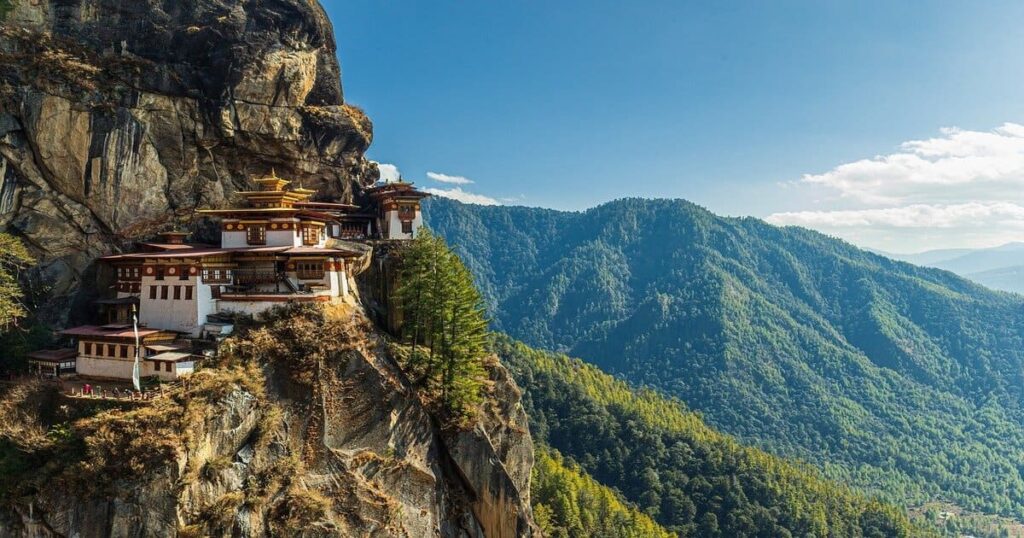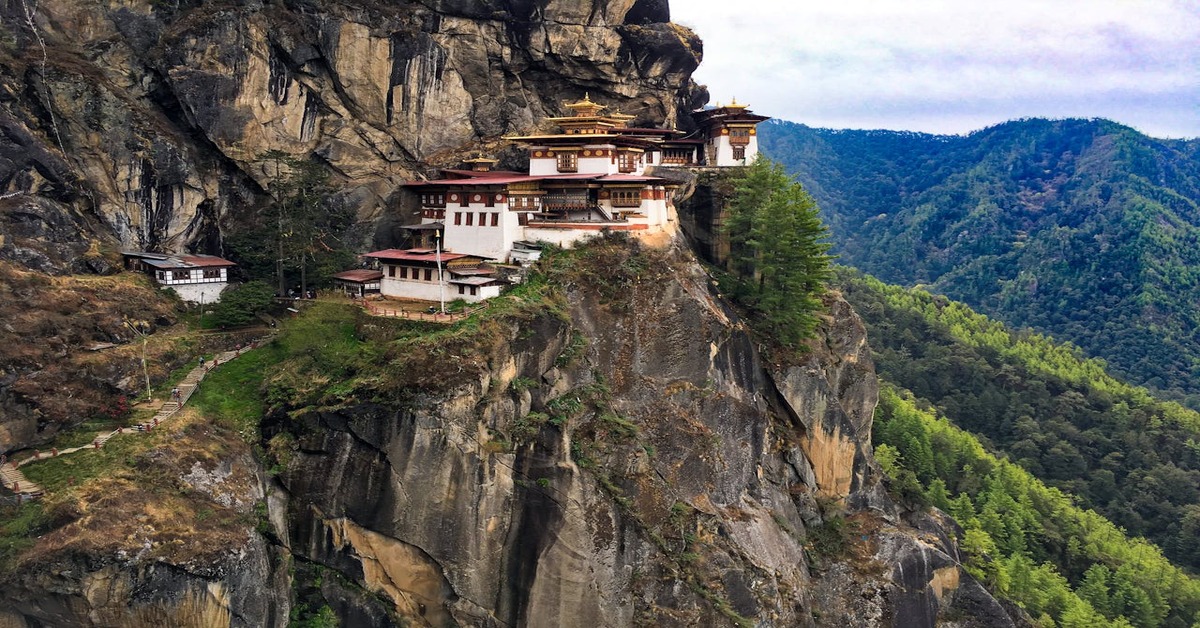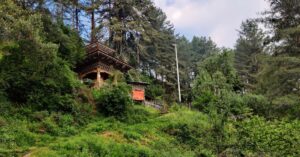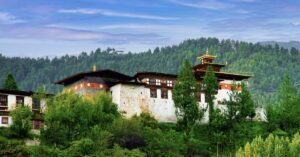Paro Taktsang is the most sacred cave in Bhutan, where Guru Rinpoche journeyed on the back of a flaming tigress in the 8th century. He meditated in the cave for 3 years, 3 months, 3 weeks, and 3 days before subjugating the malicious spirits, and concealing profound treasures for the benefit of sentient beings.
Gyalse Tenzin Rabgye built Paro Taktsang Monastery around the cave of Guru Rimpoche in 1692. The monastery is perched precariously on a hillside cliff at 3,140 meters (10,240 ft), about 900 meters (3,000 ft) above the Paro Valley of Tsento Gewog under Paro Dzongkhag.
Paro Taktsang Palphug Singye Samdrup Dzong is one of the three holiest Nyes of Guru Padmasambhava in Bhutan, the other two being Baylangdra Ney and Singye Dzong.
The Importance of Paro Taktsang
Why is Paro Taktsang important? Firstly, Bhutan Paro Taktsang is the most sacred cave of Guru Rinpoche in Bhutan. Here, he transformed himself into the wrathful entity Dorji Drolo and journeyed on the back of a flaming tigress. He meditated in the cave for three years, three months, three weeks, and three days. Then he subdued evil spirits and concealed treasures for the benefit of all sentient beings.
Secondly, Paro Taktsang is one of the four Dzongs out of the twelve meditation places, which consist of four Dzongs, four Cliffs, and four Caves entrusted to Phajo Drugom Zhigpo by Guru Rinpoche. The other three Dzongs are Tango Choying Dzong in Thimphu, Lingzhi Jago Dzong in Lingzhi, and Yangtse Thuwo Dzong above Dechenphu Lhakhang.
It is said that anyone meditating in this place will achieve enlightenment in life. Therefore, Paro Taktsang is one of the most sacred places among Guru Rinpoche’s holy places in Bhutan.
Also Read: Tango Choying Dzong, where Avalokiteshvara revealed himself as “the Wrathful Hayagriva”
The Six Wondrous Marks of Tiger’s Nest, Bhutan
- The self-formed image of Guru Dorje Drolo, the replica of the enlightened body;
- Palchen Dorje Zhonu’s (Vajra Kilaya) self-arisen body;
- Self-arisen six syllables, the replica of the enlightened Speech;
- Self-arisen stupa, the replica of the enlightened mind;
- The appearance of the five Buddha families on the mountains behind Taktsang and other appearances on the hills located before Taktsang;
- The appearance of Tiger, Dorje Drolo’s ride.
Also Read: Guru Rinpoche in Bhutan: His Visits to Bhutan and Sacred Sites
How to Trek to Paro Taktsang (Tiger’s Nest Monastery)
If you’re traveling from Thimphu, you will take around one and a half hours to reach Relangthang, the base of Taktsang Goenpa. From Paro town, where the International Airport is located, a drive to Taktsang base is just 15-20 minutes.
The famed Paro Taktsang hike takes about 3 hours at a comfortable pace. It takes over two hours for both gym-goers and casual hikers to finish. The total walking distance is about 4 km one way, with a 700-meter elevation gain. However, if you’re a novice traveler, you will face difficulty climbing up through the stone-laden trek. There are horses ready for your journey up to the midway, where a cafeteria is located. However, descending the mountain has to be done on foot, and renting a horse is not available. A one-way horse ride costs Nu 1000-1500 per horse with a horseman.
Ensure you are there early in the morning when the trail opens. That way, you can take your own sweet time with limited tourists around. The place can get crowded by midday, especially on the weekends. You will be back by afternoon within 3-4 hours.
The monastery is open from 8 am to 1 pm and from 2 pm to 6 pm. Note that this is the monastery’s timings. You can start your trek before the opening to arrive on time.
The ticket price to Taktsang for all foreign visitors (including Indians) is Nu 1000 per person. You need to buy the tickets at the base.

Tiger’s Nest Monastery Hike
The Tiger’s Nest Trek begins from Relangthang, the base of the Taktsang Goenpa. A stream activates a prayer wheel powered by water near the trail’s start. The hiking time has now shortened with the opening of the new trail. In contrast to the previous path, which shared a walkway, the new trail has a separate path for horses and humans. Along the route, more rest areas, benches, and canopies have been constructed.
After a few hours of climbing, you will reach the rest stop halfway along the Tiger’s Nest trek. There is a cafeteria at the midpoint of the hike where you can catch some rest, refresh yourself, and fill up your tummy before continuing the hike.
To get to the second viewpoint, you will then continue for an additional 2 km on a milder slope. After that, there are concrete descending steps. You will then pass by a waterfall over a bridge, followed by the final ascent of 120 steps to the main entrance of Tiger’s Nest. It takes approximately 45 minutes to 1 hour to reach the Tiger’s Nest monastery from the Taktsang cafeteria.
Before entering the monastery complex, you must deposit all your electronic and photography equipment with the sentry. Photography is prohibited inside the temple. You are required to remove your shoes and headgear upon entering the Tiger’s Nest monasteries.
Sacred Relics to See at Paro Taktsang Monastery
- Guru Druphu, the meditation cave of Guru Rinpoche;
- Khandrophug;
- Guru Sungjoenmai Lhakhang;
- Kuenra Lhakhang;
- Choeten Lhakhang;
- Guru Tshengyed Lhakhang;
- Droloe Lhakhang;
- Namsey Lhakhang;
- Tshepamed Lhakhang;
- Neypoi Lhakhang.
Historical Significance of Tiger’s Nest
What is the Paro Taktsang history? According to Khandro Yeshe Tshogyal’s biography, Guru Rinpoche came to Bhutan, Paro Taktsang, concealed treasures everywhere, and wrote their prophecies. It is said that Guru Padmasambhava journeyed to Taktsang from Singye Dzong in Lhuentse on the back of a flaming tigress (a manifestation of his consort, Monmo Tashi Khyidren), giving rise to the name Taktsang, meaning Tiger’s Nest.
Guru Rinpoche disguised himself as the wrathful entity Dorje Drolo, his eighth and final manifestation, and took refuge in a cliffside cave. He spent three years, three months, three weeks, and three days in the cave meditating. He then subjugated the malicious spirits and concealed profound treasures for the benefit of sentient beings.
Also Read: Singye Dzong, The Mystical Lion Fortress of Guru Rinpoche
The Visit of Langchen Pelgi Sengye
Langchen Pelgi Sengye, a heart son of Guru Rimpoche among the 25 disciples, followed his destiny to Paro Taktsang in 853. He chose the cave of the guardian deity Sengye Samdrup for his meditation. The place was called Pel Phug (Pel-referring to Langchen Pelgi Sengye, and Phug-referring to the cave). Since it is closer to Taktsang, it is called Taktsang Pelphug. Sometimes it is also known as Taktsang Sengye Samdrup, pronouncing the name of the guardian deity, Sengye Samdrup.
He meditated and practiced Jigten Choetoe, one of the worldly deities from the eight deities of Kagye. As a sign of his accomplishment, he could make gods and demigods as his servants.
Langchen Pelgi Sengye traveled to Nepal and died there. Before his death, he summoned his Assistant Damchen Dorji Lekpa and commanded that his body be taken to Paro Taktshang Pelphug.
Accordingly, Damchen Dorji Lekpa ferried the body from the charnel of Shitavana to Taktsang Pelphug and hid the holy body as a treasure. On top of this, he constructed a stupa. It has been an object of devotion to accumulating merits. The inside of the elevated base of the stupa “Serthi” is empty and has no relics. It is believed that the holy body of Langchen Pelgi Sengye, kept as a hidden treasure below, rises on auspicious occasions and occupies the space. It further reinforces the stupa as a more blessed and wish-fulfilling one. The stupa was recently renovated.
A Visit by Other Buddhist Luminaries
Over the next 800 years, many of Bhutan’s leading luminaries paid their respects. In the 10th or 11th century, the Buddhist Siddha Jetsun Milarepa, Pha Dampa Sangye, the Tibetan yogini Machig Labdrön, and Thangtong Gyalpo visited the cave and meditated there for three months. Thangtong Gyalpo discovered a ten-yard-long scroll handed to him by five Dakinis hidden within the cave by Guru Rinpoche himself.
Later in the same era, Gyalwa Lhanangpa, the founder of Lhapa Kagyu, journeyed here. In the 13th century, Phajo Drugom Zhigpo, the founder of Drukpa Kagyu in Bhutan, also visited and blessed the cave. According to the biography of Phajo Drugom Zhigpo, Paro Taktsang is one of the four Dzongs out of the twelve meditation places, which consist of four Dzongs, four Cliffs, and four Caves entrusted to him by Guru Rinpoche. The other three are Lingzhi Jago Dzong, Tango Choeying Dzong, and Yangtse Thuwo Dzong.
The Prophecy of Zhabdrung Ngawang Namgyal
Most famously, the cave caught the attention of the Zhabdrung Ngawang Namgyal. According to one legend, the Zhabdrung dreamed of a black-clad man granting him custody of the Taktsang Ney while staying at the Paro Rinpung Dzong.
The following morning, he informed his attendants that he was expecting a visitor, who was to be admitted without delay. Soon enough, Singye Samdrup, the guardian deity of Taktsang, arrived at the dzong dressed in the garb of a poor laborer, carrying a sack of onions. The perplexed officials guided him to the Zhabdrung’s room. There, he announced that he had come to deliver the sacred site of Taktsang. Recognizing the deity, Zhabdrung gave him a white scarf and asked him to carry it to the top of the Taktsang cliff face and declare that the region was now under the sovereignty of the Zhabdrung.
When the deity lived up to his word, the Zhabdrung vowed to build a temple called Guru Tsengye Lhakhang in his homage. However, the Zhabdrung died before he could fulfill his vow. It was left to Gyalsey Tenzin Rabgye, the 4th Druk Desi, and the Zhabdrung’s spiritual successor to complete his master’s vision.
Also Read: Guru Rinpoche in Bhutan: His Visits to Bhutan and Sacred Sites

The Construction of Paro Taktsang Monastery
When was Paro Taktsang built? Paro Taktsang Monastery was constructed in 1692 and completed in 1694. The Druk Desi ordered the construction of a grand monastery at Taktsang to fulfill the Zhabdrung’s wishes. Before construction commenced, Desi Tenzin Rabgye ascended to the mouth of the Taktsang Pelphug. He blessed the cave and performed a ceremony with a crowd of onlookers watching from below. Various miracles manifested, including a triple rainbow, a rain of flowers, and “countless other auspicious signs, never before seen or heard of, occurred at that time”.
The Druk Desi enlisted Lopon Dragpa Gyatsho, his chief architect, to oversee construction. But, according to legend, when Lopon laid a few foundation courses during the daytime, demons dismantled the work when darkness fell. Only by cutting a lock of his hair and mixing it with the mortar was the chief architect able to prevent the monsters from returning.
Description of Paro Taktsang Monastery Complex
The Paro Taktsang Architecture is a perfect example of the Draphu type of architecture, characterized by secluded hermitages built directly against sheer rock. A similar design at a much smaller scale is the Drakarpo, located just eighteen kilometers to the southeast.
Paro Taktsang Caves
There are eight caves in the monastery; four of them are comparatively easy to access. The cave where Guru Padmasambhava is believed to have entered first, on the back of the tiger, is known as the “Tholu Phuk” cave, and the one where he meditates is known as the “Pel Phuk”. A narrow passage leads into the main cave. This dark cave has a dozen images of Bodhisattvas.
The sacred text is kept in a little cell next to it; it is significant since it was written with gold dust and the powdered bone of a divine Lama.
Tiger’s Nest Monastery, Bhutan
Taktsang Lhakhang has white buildings with golden roofs, caves, and rocky terrain. Paro Taktsang Monastery consists of 4 main temples and several dwellings. They are interconnected by staircases with steps carved into the rock. Almost every structure of the monastery complex has a balcony with a breathtaking view of the surrounding area.
Near the temple’s base is the Langchen Pelgye Senge Lhakhang, built directly against the rock face. Opposite it is the largest structure, a three-level building housing a Drubkhang (meditation retreat) on the ground floor, the Guru Sungjem Lhakhang on the middle level, and the Guru Tsengey Lhakhang on the upper floor. This building has a two-tiered Jabzhi-style roof and a golden Sertog finial to indicate its sacred nature.
The Drolo Lhakhang is located in the center of the complex, beyond a curved set of stairs carved out of the rock. Higher still—and directly adjacent—is a hall housing butter lamps. Finally, at the apex of the site are two connected buildings called the Namsey Lhakhang and Tshepamed Lhakhang. The previous building perches dizzyingly at the very edge of the cliff and is a tiny, tapered, two-story structure. The Tshepamed Lhakhang stands snugly to its rear.
Also Read: Guru Rinpoche in Bhutan: His Visits to Bhutan and Sacred Sites
Guru Sungjem Lhakhang, the Shrine of Self-Speaking Guru
The Lhakhang is also known as the Temple of the Self-Speaking Statue of the Guru. The most sacred relic of Taktsang monastery is the Guru Sungjonma statue. It is one of the three Guru Statues sculptured in Punakha Dzong by Pentsa Deva.
The story goes that one of the Guru’s statues was taken to Taktsang. Upon arriving at the cliff across the sacred site of Taktsang, the monks were at a loss on how to carry the 12-foot statue across the canyon to the temple site. The statue said: “Do not worry, for someone shall come to carry me to Taktsang!” Then the statue was said to have been miraculously transported to Guru Lhakhang. This someone is believed to be Singye Samdup, the protecting deity of Taktsang. The other two statues of Guru Rinpoche sculptured by Pentsa Dewa in Punakha Dzong, who spoke, are in Goen Tshephu Ney and Ragoe Ney.
Another anecdote of the Guru Sungjoenma statue is that it has survived two major fires. The fires of 1951 and 1998 razed many of the temples and destroyed many statues inside Taktsang, but rescuers miraculously retrieved the Guru Sungjoenma statue unscathed.
The eight forms of Guru Rinpoche and his twenty-five prominent students are shown in exquisite paintings on the rock face of the temple. It also includes the throne used by Gyalse Tenzin Rabgye. All the sacred objects about the Eight Manifestations of Guru Rinpoche were built by famous Niwari artisans Pentsa Deva, Dharma Deva, and Dharmashri.
All the temple complexes have exquisite mural wall paintings. Trulku Mipham Chogyal, renowned in Tibet for their mastery of the Men-ri and Khen-ri styles of paintings, is credited with the paintings of the murals in the Taktsang monastery.
Most Auspicious Day of the year for Paro Taktsang
The sacred cave of Guru Rinpoche opens once a year on the 30th day of the 5th lunar month. However, the Dzongkhag Administration, Paro, announced that from 2024, the main cave of Guru Rinpoche will be opened for 3 days to display the holy relic of Paro Taktsang, Phurb. The cave will open from 4 AM to 5 PM. However, photography is strictly prohibited. Even before the gilded door to this holy site is open, pilgrims from all walks of life from all over the country flock to Paro to hike up and be a part of this most auspicious religious event.
To avoid swelling crowds during the day, some start waking up during the wee hours of the morning under the moonlight to be amongst the first ones to enter the sacred cave. It is thought that if a pilgrim can enter the cave, they will be able to accrue merit and ultimately free their souls in the direction of enlightenment. To seek refuge in Guru Rinpoche, pilgrims go from all around Bhutan to this location, particularly on this auspicious day. You can visit major pilgrimage sites in Paro with the Bhutan Pilgrimage Package.

Best Time to Visit Taktsang Tiger’s Nest Monastery
The best time to visit the Taktsang Monastery is during the autumn (September to November) and spring (March to May) seasons. The weather is usually clear, and the path is easy to trek with a pleasant temperature.
Summers get too hot at times. The path to the monastery becomes extremely treacherous and slippery during the monsoons (July – early September). On the other hand, winters (December – February) are cold in Bhutan, and snowfall is common.
We recommend avoiding the visit during the cold winter months of January and February, and the rainy and hot monsoon season from June to September, unless you love snow and rain.
If you want to see the main cave of Guru Rinpoche, which opens once a year, you must visit on the 30th day of the 5th lunar month of the Bhutanese calendar.
What to Bring on a Tiger Nest Hike
Since the journey involves mainly trekking, you need to layer your clothes. If you are not hiking in the winter, wear a base layer like a t-shirt or a day shirt. Wear it with high-quality thermal gear or a fleece jacket. You may want to take it off during midday, but you will need it as you reach the top.
Apart from that, we suggest you keep another waterproof jacket or a windshield that you can wear in case it drizzles on the way or if you want to keep yourself extra warm.
If you are traveling during the winter, ensure you have good gear to keep you warm. Add a couple of body warmers for both the bottom and top.
Wear good hiking shoes. It would be best if you could wear trekking shoes. But don’t wear sandals, slippers, flats, or heels.
Keep something to eat with you, along with some water. You can hardly buy any food in the area except for the one cafeteria midway.
Sacred Places to Explore in Paro
Paro Rinpung Dzong: Also known as Paro Dzong, it is one of the 16 dzongs built by the Zhabdrung Ngawang Namgyal in Bhutan in 1646. It was built as a defensive fortress against the Tibetan invasions. It is one of the biggest dzongs in Bhutan.
National Museum of Bhutan: It is located just above Paro Rinpung Dzong. The National Museum, housed in a former watchtower, Ta Dzong, showcases a vast collection of ancient Bhutanese artifacts.
Hungrel Dzong: It was a fortress built on the sacred site of Guru Rinpoche. The Dzong was constructed by Drung Drung Gyelchog in the 15th century.
Kyichu Lhakhang: It is one of the oldest temples in Bhutan, built by Songtsen Gampo in 659 CE. It was built as part of the 108 temples constructed in a single day to pin down an ogress who was opposed to the spread of Buddhism.
Druk Choeding Lhakhang: Also known as Tshongdoe Naktshang, it is a two-story temple built by Lama Ngawang Chhogyal in Paro in 1525.
Zuri Dzong: One of Bhutan’s oldest and most historically significant fortresses in the sacred site of Namthong Karpo. Built in 1352, it served as a defensive structure against invasions.
Frequently Asked Questions
Who built Paro Taktsang?
Paro Taktsang, also known as the Tiger’s Nest Monastery, was built by Gyalse Tenzin Rabgye, who was the fourth temporal ruler of Bhutan, around the sacred cave where Guru Padmasambhava meditated in 1692 following instructions from Zhabdrung.
What is Paro Taktsang famous for?
Bhutan Paro Taktsang is famous for being a sacred Buddhist site clinging to a cliff in the Paro Valley of Bhutan. It is known as the “Tiger’s Nest” because Guru Rinpoche, who brought Buddhism to Bhutan in the 8th century, arrived at the site on the back of a flying tigress and meditated in a cave there for three years, three months, three weeks, three days, and three hours.
How difficult is the hike to Paro Taktsang?
The hike to Paro Taktsang, also known as the Tiger’s Nest Monastery, is considered moderately difficult for most people. The trail is about 3 km one way, with a total round-trip distance of 6 km. It involves a steep ascent of 900 meters from the starting point at 2,600 meters to the monastery at 3,120 meters. The trek typically takes 2-3 hours to reach the monastery, depending on your pace and fitness level.
The hike is well-defined and heavily trafficked, so it is doable for most people who take their time. Your age, fitness level, and whether you are acclimatized to the altitude can affect the difficulty. Renting a walking stick or trekking pole can make the hike easier. Horses are available to carry visitors halfway to the cafeteria, but the rest of the hike must be done on foot. With proper preparation and pacing, most visitors can complete the hike and visit this sacred Buddhist site.
Why is it called the tiger’s nest?
The Paro Taktsang Monastery is known as the Tiger’s Nest because Guru Rinpoche, who brought Buddhism to Bhutan, was carried up the mountain on the back of a tigress, which was a consort of Guru Rinpoche.
What do people think about Paro Taktsang?
For the Bhutanese people, Paro Taktsang holds immense spiritual significance as it is where Guru Padmasambhava, who brought Buddhism to Bhutan, meditated in the 8th century. It is considered one of the country’s holiest sites and a pilgrimage place for Buddhists worldwide.
What is the main statue of Paro Taktsang?
The main statue of Paro Taktsang is of Guru Rinpoche, called the Guru Sungjoenma Statue, which is housed in the main temple of the monastery complex.
Enjoyed reading this blog?





Today I came across this wonderful and insightful page where I learn so many important lessons about our Bhutan’s pilgrimage sites.
Thank you for posting such a important and insightful things about sacred places